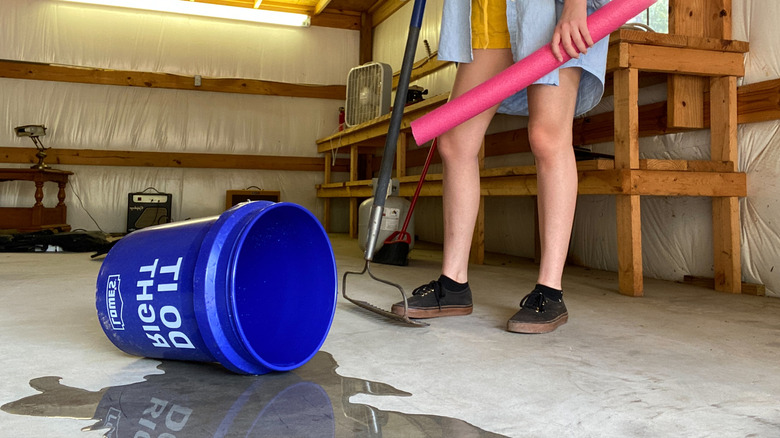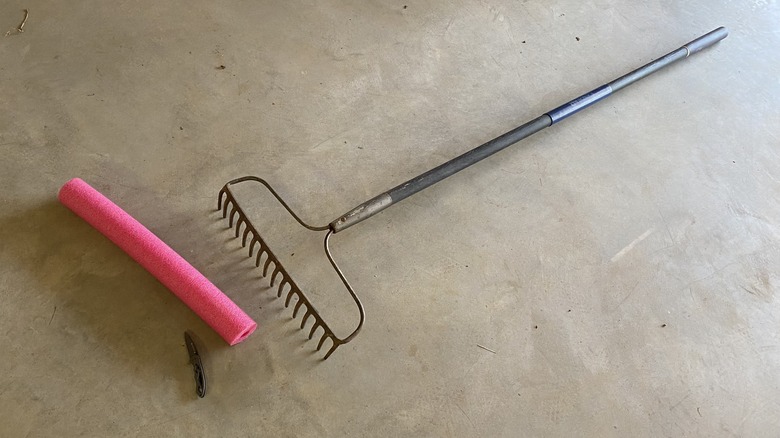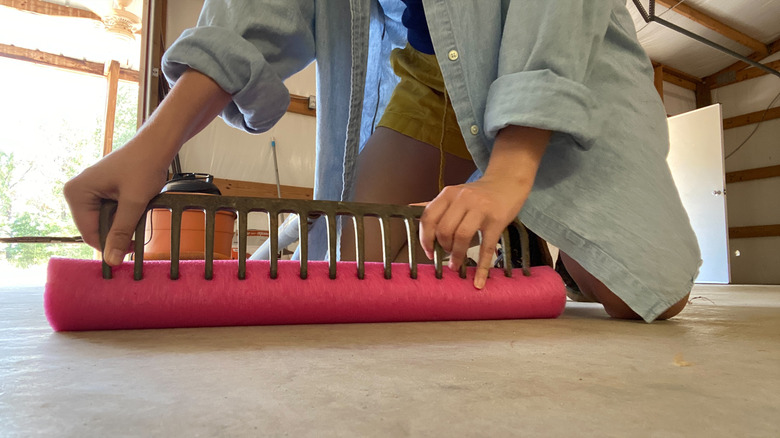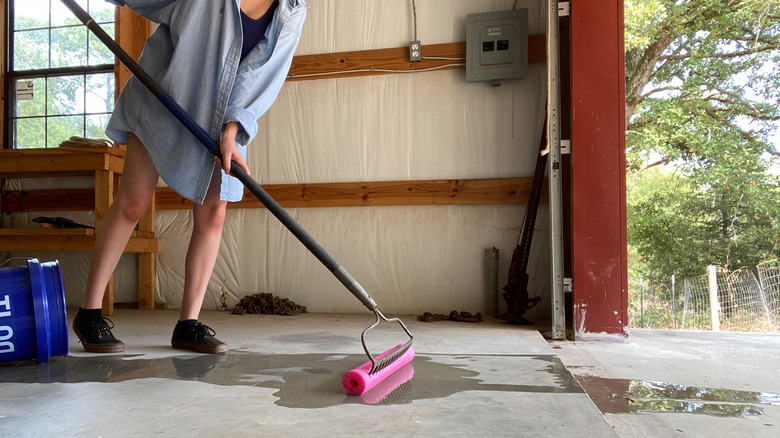We Tried Making A Squeegee From A Rake And A Pool Noodle With Positive Results
When you picture a "squeegee," you may imagine a small, handheld tool with a rubber blade used for cleaning glass or windows. Floor squeegees, on the other hand, are much larger and typically used to push water, icy slush, or snow across a concrete floor (and presumably out the door). They're especially useful for garages and barn spaces, but may also be good for cleaning balconies, porches, and patios. Indoors, a squeegee can even be used to clean up spills and scrape dirt or stuck-on residue from tile or concrete floors.
While such a tool has several uses, many households don't own a real floor squeegee. After all, how often do you actually need to push mass quantities of liquid across your floor? But in an emergency like a pipe leak, spilled bucket, or even a flood, you may wish you had one.
Luckily, in a pinch, you may be able to transform a few basic supplies into your own floor squeegee tool. A popular internet hack suggests sliding a piece of a foam pool noodle over the tongs of a rake to create a DIY squeegee, but does it really work? We decided to put this idea to the test so you'll know exactly what to do in an emergency. Learn more about how we built and tested our own DIY floor squeegee and the splashing results that followed.
Simple supplies and setup
To create the DIY floor squeegee, we used a long-handled garden rake (also known as a bow rake). Most sources recommend using a garden rake, which has a wider head and stiff, unbendable tines. Other rakes, like a leaf rake, may be harder to use for this hack, but might be worth a try if that's all you have! You'll also need a utility knife and a standard-sized foam pool noodle, cut a little longer than the head of the rake. We happened to have the perfect piece left over from our portable potty pool noodle hack!
Because a floor squeegee is most commonly used to push water out of a building, we tested the DIY floor squeegee in a garage with unsealed concrete floors. To simulate a spill accident or water leak, we filled a 5-gallon multipurpose bucket with about 1/2 gallon of water, then tipped it over on the floor. While it might not seem too important in a garage, it's not good to let water soak into your concrete, as it can decrease its durability and even foster mold. Luckily, we had our DIY squeegee hack ready to roll!
Creating and testing our squeegee
Constructing the floor squeegee is almost self-explanatory. After you've used the utility knife to cut the noodle down to size, set the noodle segment underneath the tongs of the rake. Cutting the pool noodle so it extends at least one inch on either side of the rake head will ensure that the foam won't easily tear. With both hands, firmly push down on the rake head until the tongs pop through the first layer of foam. You don't want the rake to pierce through the other side of the noodle, or else it might scrape your floor while in use.
Pushing through the foam and be a little tough, so be careful not to slip and hurt your fingers. If the tongs on the rake are too dull to push through the noodle, you can also try slicing one side of the noodle open, wrapping it around the tongs, and securing it in place with zip ties. After building the squeegee, we tried pushing the spilled water puddle out through the open garage door. For a little extra fun, we also decided to try the squeegee on exterior window glass, the garage door, and exterior metal walls.
This hack was a sweeping success
We were surprised to learn that this DIY pool noodle squeegee was actually quite effective! It made short work of the puddle on the garage floor, shoving the excess water out the door with minimal effort. Even though the construction was simple with few supplies needed, this squeegee seemed to have endless possibilities for the garage, barn or stable, porch, or sidewalks. Not only was it effective with a water puddle, but we suspect this squeegee could also clear up snow and slush with ease.
The squeegee wasn't very effective at cleaning windows, garage doors, or metal walls, but you could likely wrap the noodle in a towel to give it more cleaning power.
While the hack was an overall success, there were some minor quirks worth mentioning. Unlike a pre-made squeegee with a thin rubber blade, this DIY squeegee took a few swipes to clear all the water off the floor. Because it didn't have a rubber edge, the DIY squeegee also isn't the best tool for scraping up stuck-on gunk or ice, and the pool noodle may start to degrade after multiple uses. In the end, however, we still think this is a great hack to know in an emergency and an awesome way to upcycle last summer's pool noodles.



